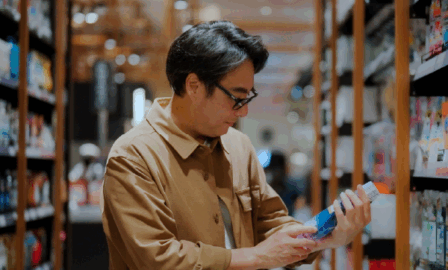Why is Consumer-First Marketing Crucial?
It’s no secret that today’s consumers have no shortage of options. Every purchasing decision made comes with an endless number of potential choices, constantly evolving to fit ever-changing preferences. Manufacturers can no longer rely on blind product or brand loyalty like they could in the past. The effects of the pandemic have only heightened this. Not only is online shopping at an all-time high (making physical proximity barely a purchase factor in consumers’ minds), but supply issues and a lack of product availability in 2020 resulted in more consumers trying out new brands and products.
All in all: brands are increasingly struggling to stay relevant and top-of-mind with consumers in today’s fast-paced environment. This is why consumer-first marketing is so important.
When trying to address consumer-first marketing, many brands look to digital but fall prey to shiny-object syndrome. They see DTC, big data, social media and eCommerce as solutions for their struggles rather than tools to help overcome them. They go all in on, investing thousands (sometimes millions) of dollars into these tactics, hoping that embracing new channels can act as a panacea. While these arenas are key focus areas for any modern brand, the bottom line is that without a true consumer-first approach, these tactics won’t be successful.
Consumer-First Marketing
So, what is “consumer-first” marketing? How can you tell if your brand is successfully placing consumers at the center? True consumer-first thinking goes beyond driving reach, pursuing trends, or developing innovative products and instead reaches into the heart of the consumer, understanding their wants and needs and offering a product or service that addresses them. It means putting yourself in their shoes, understanding their challenges and catering to them. Now more than ever, it means creating products and services that are intended to make their lives better or easier and demonstrating just how impactful that product or service can be.
Developing a Consumer-First Strategy
This thinking must start at the top and flow into every element of your business. Understanding the consumer’s perspective and challenges and developing a strategy that aligns with those is pertinent to being a true consumer-first company. In order to do this, you must start with the “why.” Why is your consumer acting a certain way? Why is there a pain point in their path to purchase? Why are they buying your product? Why are they buying your competitor’s?
Understanding the “why” will allow you to get to the heart of the consumer’s challenges. Once you understand that, you’ll be able to craft a strategy that solves for the true problem, rather than developing a band-aid solution. While developing your strategy, you need to make sure you’re always re-centering on the “why.” It’s easy to get distracted or fall down rabbit holes, so don’t be afraid to backtrack and to ask yourself, and your team, “why?”
Consumer-First Marketing in a Data-Driven Era
Today, companies have a wealth of data readily available. Data on when, how, where and why consumers shop. Companies invest in path to purchase data, preference data, browsing data, and so much more. In fact, many companies are drowning in data.
To be consumer first, data is extremely important. But, equally important, is leveraging smart data over big data. This means that before you invest money into a new data set or solution, you’re asking yourself “why?” Storing massive amounts of data can get expensive and messy – so having a data strategy that aligns with your overarching consumer strategy can be helpful.
But what do you do with all that data once you have it? Today’s consumers expect everything to be personalized. This goes for the marketing that you use to attract them to the product that you sell them to the contact center that you use to communicate with them. Studies have shown that 86% of consumers say personalization plays a role in their purchase. Every touchpoint should be as personal as possible, and data is the key to doing this right.
Your digital marketing strategy, for example, can leverage your data to create personalized ads that cater to an individual’s preferences by changing the promotion, color, and even placement. By leveraging A/B testing, you’ll gather a wealth of performance data to improve your digital marketing capabilities and ensure that you’re speaking to consumers in a way that resonates with them.
Going beyond marketing, data can be extremely important when we think about innovation. All the data that you’re collecting can help you understand your consumer’s “why” and will allow you to change course if necessary. It will also enable you to think about the future, understand how your consumer’s needs are changing, and ensure that you stay relevant by incorporating their changing needs and preferences into your product and strategy.
Listening to the Consumer
Being a consumer-first organization doesn’t stop at the strategy. Once you’ve developed and implemented a consumer-first marketing plan, you need to make sure you’re constantly listening to the consumer and adjusting. This is where feedback loops can be extremely helpful. Organizations need to embrace open lines of cross-functional communication. If consumers are unhappy and sharing that sentiment on Twitter, then the quality and product teams need to be looped in. If consumer shopping habits change, then supply chain and sales need to be advised. Consumer-first companies need to have strong cross-functional communication to enable them to ever-evolve with their consumers.
Emphasize Convenience
In this day and age, consumers expect a seamless shopping experience from start to finish. To successfully execute consumer-first marketing, you must be able to offer your consumers a pleasant experience with an easy, convenient path to purchase. And the stakes are high – with so many options out there, your brand can quickly lose a customer for life from a single bad experience.
On the other hand, the brands that excel at this have, not coincidentally, been able to maintain their strong customer loyalty at a time when the idea of customer loyalty overall has eroded. Take Starbucks’ app and rewards and loyalty program, for example. Starbucks spent years investing in streamlining their phone application to make it as consumer-centric as possible. The app allows members to place customized orders, earn loyalty points, pay on their phone, and skip the line to pick up their drink at a time of their choosing. No lines, no waiting whatsoever, no hassle for the consumer. The result? A whopping 48 percent of app users regularly use it to purchase, making it the most successful loyalty program app among major restaurants.
Consumer-First is No Longer an Option : It’s Table Stakes
Consumer-first marketing and thinking has been talked about by many companies for a long time, but today’s consumers now expect such a mindset. With so many options to choose from, their loyalty will be won by brands that resonate with them and put their wants and needs first.
Companies that meet consumer needs, understand consumer wants, and align with consumer values will be the ones to stay top of mind and win at checkout. Being consumer-first is about more than just talking the talk; it’s about truly understanding your consumer’s why and building an organization that is centered around that idea. It requires dedication and collaboration from all team members and the ability to be nimble and act quickly.
Subscribe to Clarkston's Insights



